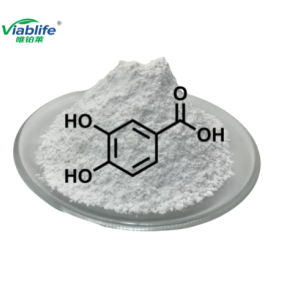3,4-Dihydroxybenzoic Acid
3,4-Dihydroxybenzoic Acid / CAS : 99-50-3
| Appearance | White to yellowish crystalline powder | UN | - |
| HS | 29182900 | DG Class | - |
| Synonyms | 4-Carboxy-1,2-Dihydroxybenzene; Protocatechuic Acid; Protocatehuic Acid; Protocatechuate; PCA; Benzoic Acid,3,4-Dihydroxy; 3,4-Dihydroxy-Benzoic Acid; 3,4-Dihydroxybenzoate; Benzoic Acid, 3,4-Dihydroxy-; Protochatechuic Acid; 4,5-Dihydroxybenzoic Acid; Catechol 4-Carboxylic acid; Protocatechuic acid(PCA) | ||

- Email: jim.yu@mail.chemball.com
- Whatsapp: 0086-18334372322
- Tel: 0086-571-8627 3270
latest price
Overview
Benefits
Purer appearance and color: Viablife's Protocatechuic Acid is a pure white powder with uniform particle size.
Higher purity: Biosynthetic Protocatechuic Acid, with higher purity and fewer impurities.
Uniform particle size: Viablife's Protocatechuic acid strictly controls 80 mesh particle size so that protocatechuic acid has a more uniform particle size, better fluidity, and can be quickly dissolved.
The lower price: The price of Protocatechuic Acid is 5%~10% lower than that of our competitors.
Specification
Items of Analysis | Specification | Results |
Appearance | White or almost white crystalline powder | Complies |
Assay | ≥99.0% | 99.73% |
Solubility | Soluble in hot water | Complies |
Moisture | Not more than 0.5% | 0.25% |
Any individual impurity | Not more than 0.2% | Complies |
Residual solvents | Must not be checked out | Complies |
Uses
Antioxidant activity: PCA is a potent free radical scavenger that can inhibit cellular oxidative stress and DNA damage, exhibiting significant antioxidant activity.
Anti-inflammatory activity: PCA has the ability to inhibit inflammatory responses and promote inflammation repair, reducing inflammation-induced pain and discomfort.
Anti-cancer activity: PCA can inhibit tumor cell growth and metastasis, and promote tumor cell apoptosis, exhibiting anti-cancer activity.
Hypoglycemic activity: PCA can increase insulin sensitivity, promote glucose uptake and utilization, and lower blood glucose levels, exhibiting hypoglycemic activity.
Hepatoprotective activity: PCA can alleviate liver damage and fibrosis, promote liver cell regeneration and repair, exhibiting hepatoprotective activity.
Antibacterial activity: PCA can inhibit the growth and reproduction of various bacteria and fungi, exhibiting antibacterial activity.
Other activities: PCA also exhibits various activities such as blood pressure-lowering, anti-aging, and beauty-enhancing, and is therefore widely used in the fields of health products, drugs, and cosmetics.
Animal feed additive: The addition of protocatechuic acid in the feed formula can play an anti-virus role. When it is applied to high-fat feed, it can effectively eliminate the intestinal micro ecological environment disorder and liver metabolic burden and damage caused by high-fat feed, which is conducive to improving the utilization of nutrients and improving animal immunity.
Dye synthesis: Protocatechuic acid can be used as an intermediate for dye degradation, and also can be used to synthesize ultraviolet absorbers.
Material synthesis: Chitosan combines with protocatechuic acid to form a graft copolymer, which is an excellent mulching film material.
Drug synthesis intermediates: Protocatechuic acid is a drug intermediate such as veratridine (an inhibitor of sodium channel inactivation), mepivalin hydrochloride (for the treatment of intestinal spasm), picroside II (for the treatment of hepatitis B), etopride hydrochloride (a new gastrointestinal motility drug), and Yimixing (an anesthetic).
Picture
Properties
Summary
Attribute classification
Plant and Other Extracts > Plant Extracts

























